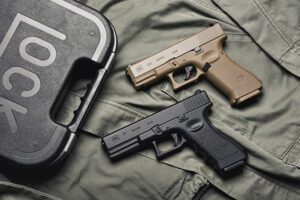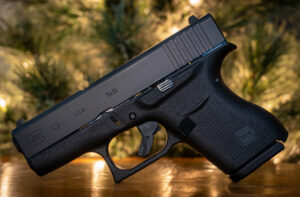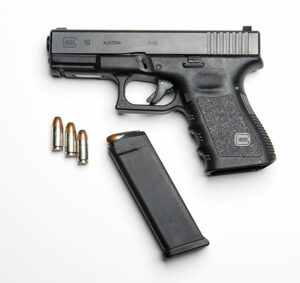Glock has produced some of the most reliable and ubiquitous firearms in history.
Yet, there is often confusion about how Glock numbers its handguns—and the correlation, if any, to other Glock model numbers.

For example, the Glock 17 holds 17 rounds. So, following that logic, the Glock 19 would hold 19 rounds. Except that it holds 15 rounds.
The Glock 20 is a 10mm handgun. As is a Glock 40. Why wouldn’t the Glock 40 be a .40 S&W? Well, because the Glock 22 is a .40 S&W.
And the Glock that’s a .22LR? Well, it’s a Glock 44. So, obviously, the Glock 44 isn’t a .44 magnum because Glock never made such a thing.
And if you’re looking for a Glock that fires a .45 ACP round? Well, those are the Glock 21 and Glock 30.
There is a Glock 45, however, and it’s a 9mm, just like the Glock 43 and Glock 48.
So, how DOES Glock number its handguns?

THE NUMBERING SYSTEM (WITH A LITTLE HISTORY)
Glock started off as a curtain rod company, of all things. Gaston Glock was an expert in polymer manufacturing. From there, Glock assembled a team of firearms experts to respond to the request for a modern pistol on the part of the Austrian Armed Forces.
After winning the bid, the firearm that was created, the Glock 17, was adopted by several military and police organizations.
Since then, Glocks have had their model numbers assigned as a design is STARTED, not when the handgun is RELEASED.
For example, the Glock 20 and Glock 21 were in development before the Glock 22 and Glock 23, but the 22 and 23 were released first.
But, Glocks aren’t just distinguished by their model number. There are also different GENERATIONS of each model.
GENERATIONS
There is no set timeline on when Glock generations begin or end. Generational improvements for Glock just happen when needed.
Earlier generations don’t necessarily disappear when a new one is released. Older and newer generations alike can be produced or improved in tandem.
THE GENERATIONS
GEN 1
Generation 1 is just one gun. The Glock 17. (The “17” comes from the fact that the pistol was the 17th patent obtained by the company.)
GEN 2
More sizes and calibers were introduced into the Glock lineup. The magazine baseplate was changed, along with other small changes. And some were made with Picatinny rails—these are sometimes referred to as Gen 2.5.
GEN 3
Grips had finger grooves added. Thumb rest scallops added. Rails as a standard option. Internal modifications including a cross pin above the trigger pin.
GEN 4
The Pistol grip was made slightly smaller. Plus, a modular backstrap system allowed for changes to the grip size. More texturing on the grip—and the magazine release is reversible for left-handed folks.

GEN 5
Finger grooves removed. Flared magazine well. Trigger guard features a relief cut to allow for higher grips. Ambidextrous slide lock. Match grade barrels.
The Glock 17 spans all 5 generations. Some models only have one or two generational variants. Others (like the Glock 43) were released between generational differences, and don’t neatly fit into a generational timeline.
PLUS, CATEGORIES!
In addition to model numbers and generations, Glocks are also classified by category. The categories are: Standard, Compact, Subcompact, Competition, Long Slide, and Crossover.
Standard is what it says. Pretty standard for duty and home defense. Barrel lengths of 4.49 and 4.61 inches.
Compacts are, well, maybe not that compact. Glock compacts have barrel lengths of 4.02 inches. Smaller than a Standard Glock, but not exactly small. Still, the most popular Glock size category.

Subcompacts are intended by Glock for concealed carry. They feature barrel lengths of 3.43 or 3.78 inches depending on caliber. Frames are very short.
Slimlines are created to be concealed. Beavertailed frames, single stack magazines, textured grips, and a reversible magazine catch are some of the attributes.
Competition and Long Slide guns are predominantly competition shooting firearms. Frames are the standard size, with barrels and slides that are longer—allowing for higher velocity, and a longer sight radius, with lessened recoil and muzzle flip. For example, the Glock 34 is the Long Slide version of the Glock 17; they share the same frame, but have different “upper” parts.
Crossovers have full-sized grips, but compact slides. For example, the Glock 45 is a crossover that could almost be described as “a 17 frame with a 19 slide.”

Even the most fervent advocates of the Glock brand can be taken aback by the model numbers. But rest assured, there is a definitive method to the madness.
This article is intended for commentary and entertainment purposes only and is not endorsed or affiliated with Glock, Inc. Or Glock, GmbH. Brand names and model numbers listed in this article are for reference purposes only and are the property of their respective owners.

